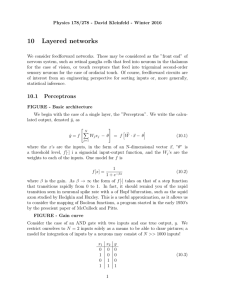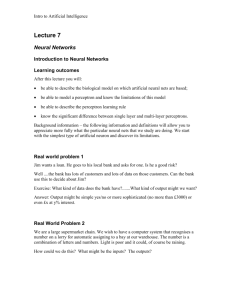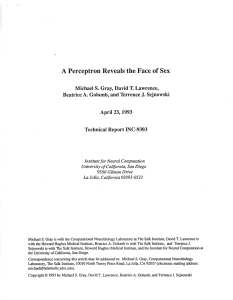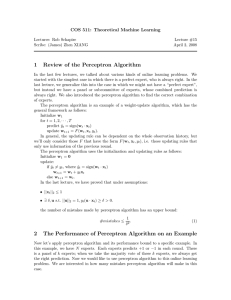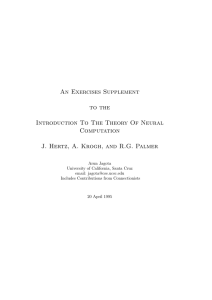Homework_ _ Graduate AI Class Fall ____
advertisement
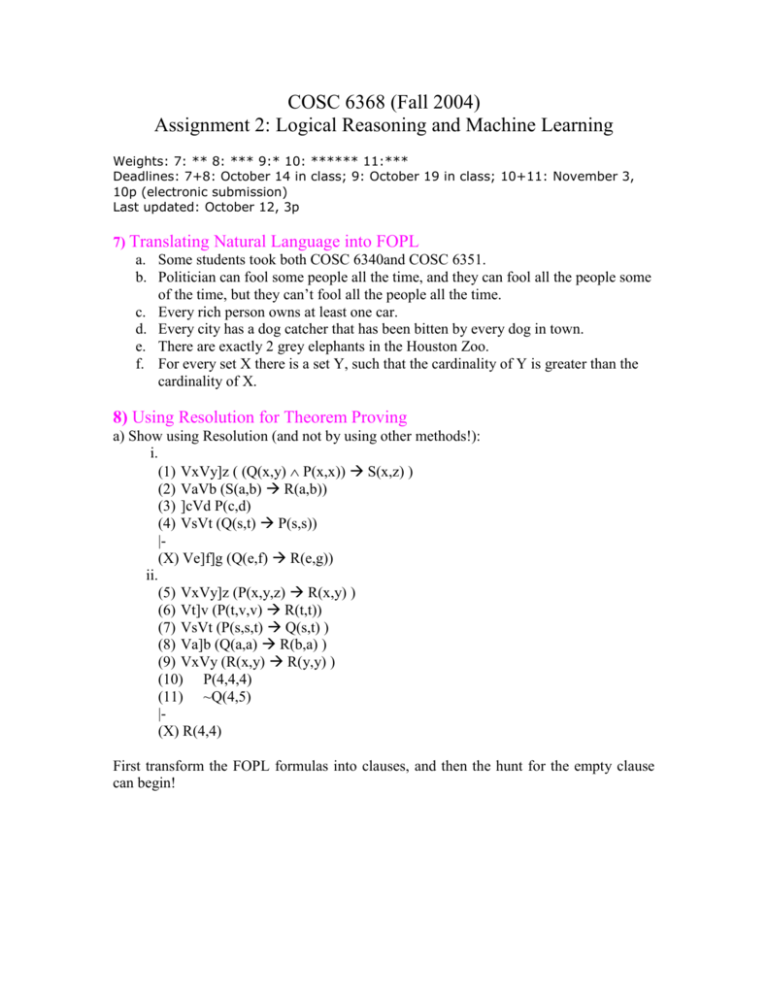
COSC 6368 (Fall 2004) Assignment 2: Logical Reasoning and Machine Learning Weights: 7: ** 8: *** 9:* 10: ****** 11:*** Deadlines: 7+8: October 14 in class; 9: October 19 in class; 10+11: November 3, 10p (electronic submission) Last updated: October 12, 3p 7) Translating Natural Language into FOPL a. Some students took both COSC 6340and COSC 6351. b. Politician can fool some people all the time, and they can fool all the people some of the time, but they can’t fool all the people all the time. c. Every rich person owns at least one car. d. Every city has a dog catcher that has been bitten by every dog in town. e. There are exactly 2 grey elephants in the Houston Zoo. f. For every set X there is a set Y, such that the cardinality of Y is greater than the cardinality of X. 8) Using Resolution for Theorem Proving a) Show using Resolution (and not by using other methods!): i. (1) VxVy]z ( (Q(x,y) P(x,x)) S(x,z) ) (2) VaVb (S(a,b) R(a,b)) (3) ]cVd P(c,d) (4) VsVt (Q(s,t) P(s,s)) |(X) Ve]f]g (Q(e,f) R(e,g)) ii. (5) VxVy]z (P(x,y,z) R(x,y) ) (6) Vt]v (P(t,v,v) R(t,t)) (7) VsVt (P(s,s,t) Q(s,t) ) (8) Va]b (Q(a,a) R(b,a) ) (9) VxVy (R(x,y) R(y,y) ) (10) P(4,4,4) (11) ~Q(4,5) |(X) R(4,4) First transform the FOPL formulas into clauses, and then the hunt for the empty clause can begin! b) Prove using resolution (and not using other methods) (A1) Every man loves at least one woman. (A2) Every woman loves at least one man. (A3) Women do not love men that are not intelligent. (A4) Fred is an intelligent man. |(A) There is at least one intelligent woman in the world. c) Is it possible that a theorem prover runs forever, when trying to prove statement (A) in problem 8.b? If your answer is no, give reasons for your answer! If your answer is yes, explain under which circumstances the theorem prover might generate clauses “forever”? What are the practical implications of your answer for resolution theorem provers in general? 9) Decision Tree Induction We would like to predict the gender of a person based on two binary attributes: leg-cover (pants or skirts) and beard (beard or bare-faced). We assume we have a data set of 20000 individuals, 10000 of which are male and 10000 of which are female. 80% of the 10000 males are barefaced. Skirts are present on 50% of the females. All females are bare-faced and no male wears a skirt. i) Compute the information gain of using the attribute leg-cover for predicting gender! ii) What is the information gain of using the attribute beard to predict gender? iii) Based on yours answers to i) and ii) which attribute should be used as the root of a decision tree? 10) Using C5.0 --- Knowledge Discovery for the NBA The goal of this project is to explore how decision tree tools can help in predicting the free throw goal percentage (FT%) of a basketball player using the following NBA-Player Data Set and the popular decision tree tool C5.0. The goal of the project is to predict a player’s free throw percentages based on other attributes of the player. Free throw percentage is defined as an attribute that takes values HIGH and LOW. Tasks to be solved and questions to be answered: Convert the NBA-data set into proper test-set training set pairs. When evaluating the training performance for the data set use 3-fold cross validation (take the NBA-dataset and create a benchmark by partitioning it 3 times into a training set of approx 120 players, and a test set of 60 players. To speed up the project, you can use the base datasets that were generated by the group Silver in the year 2000 that can be found following the following link: http://www2.cs.uh.edu/~wxstrong/AI/2000fall.html Run C5.0 with various parameter settings1 and collect and interpret the results. Report the best decision tree or trees you found together with the parameter settings that were used to generate these trees. Analyze the decision trees the have a high accuracy in predicting 1 Focus your analysis just on 2 of the C5.0 parameters: pruning CF-factor and minimum number of cases. good free throw shooters --- what does it tell us about the classification problem we were trying to solve; e.g. did the decision tree approach work well/work badly for the problem at hand; did we find anything interesting that distinguishes successful shooters from unsuccessful shooters in the NBA? Did your analysis indicate any attributes that have a strong impact on a player's capability to be a good free throw shooter? Did your results match your expectations? Where your results stabile (hint: compare the decision trees you obtain for each fold of cross validation; additionally create the decision tree by using the complete dataset using the same parameter setting)? Finally, write a 4-5 page (single spaced) report that summarizes your results. 11) Neural Networks Assume we have the perceptron that is depicted in Fig. 1 that has two regular inputs, X1 and X2, and an extra fixed input X3, which always has the value 1. The perceptron's output is given as the function: Out= If (w1*X1 + w2*X2 + w3*X3) > 0 then 1 else 0 Note that using the extra input, X3, we can achieve the same effect as changing the perceptron's threshold by changing w3. Thus, we can use the same simple perceptron learning rule presented in our textbook to control this threshold as well. A. We want to teach the perceptron to recognize the function X1 XOR X2 with the following training set: X1 X2 X3 Out 1 1 1 0 0 1 1 1 1 0 1 1 0 0 1 0 Show the change in the weights of the perceptron for every presentation of a training instance. Assume the initial weights are: w1=0.3, w2=0.3, w3=0.4 Important: Do the iterations according to the order of the samples in the training set. When you finish the four samples go over them again. You should stop the iterations once you get convergence, or when the values you get indicate that there will be no convergence. In either case explain your decision to stop the iterations. Assume in your computations that the learning rate is 0.3. Sample# X1 X2 X3 Output True_Out Error w1 w2 w3 0 0.3 0.3 0.4 1 1 1 1 0 2 0 1 1 1 3 1 0 1 1 4 0 0 1 0 5 1 1 1 0 6 ... ... ... 7 8 ... ... ... ... ... ... B. This time, instead of being limited to a single perceptron, we will introduce hidden units and use a different activation function. Our new network is depicted in Fig. 2. Assume that the initial weights are w14 = 0.3, w15 = 0.1, w24 = 0.2, w25 = 0.6, w34 = 0.1, w35 = 0.1, w36 = 0.1, w46 = 0.5, and w56 = 0.2. The training set is the same as in (A). Use =0.2 as your learning rate. Show what the new weights would be after using the backpropagation algorithm for two updates using just the first two training instances. Use g(x) = 1/(1+e**(-x)) as the activation function; that is g'(x)=(e**(-x))/(1+e**(-x))**2). S# X1 X2 X3 Out True_Out Error w14 w15 w24 w25 w34 w35 w36 w46 w56 0 0.3 1 1 1 1 0 2 0 1 1 1 0.1 0.2 0.6 0.1 0.1 0.1 0.5 0.2


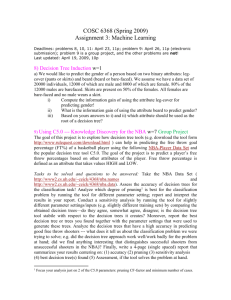
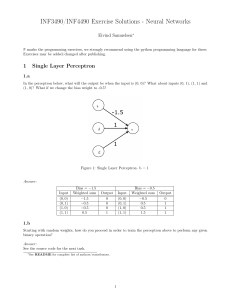
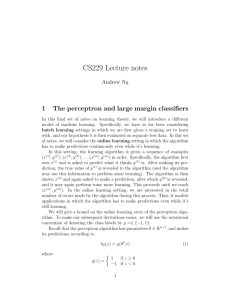
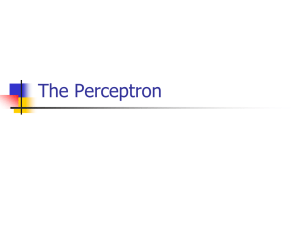


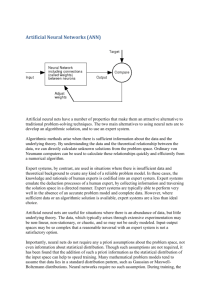
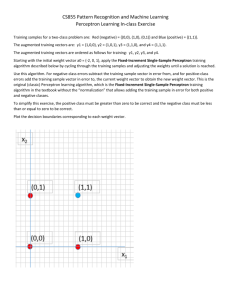
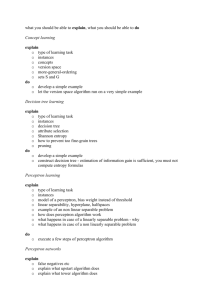
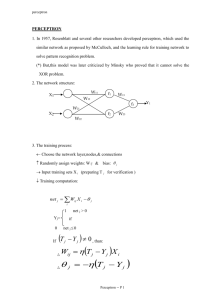
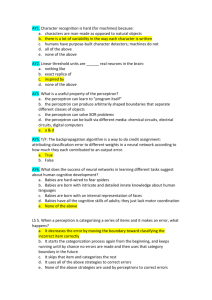
![Neural Networks [Year 3]](http://s3.studylib.net/store/data/007742788_2-c93906c9d30e69e39be0a3cbca2d4955-300x300.png)
